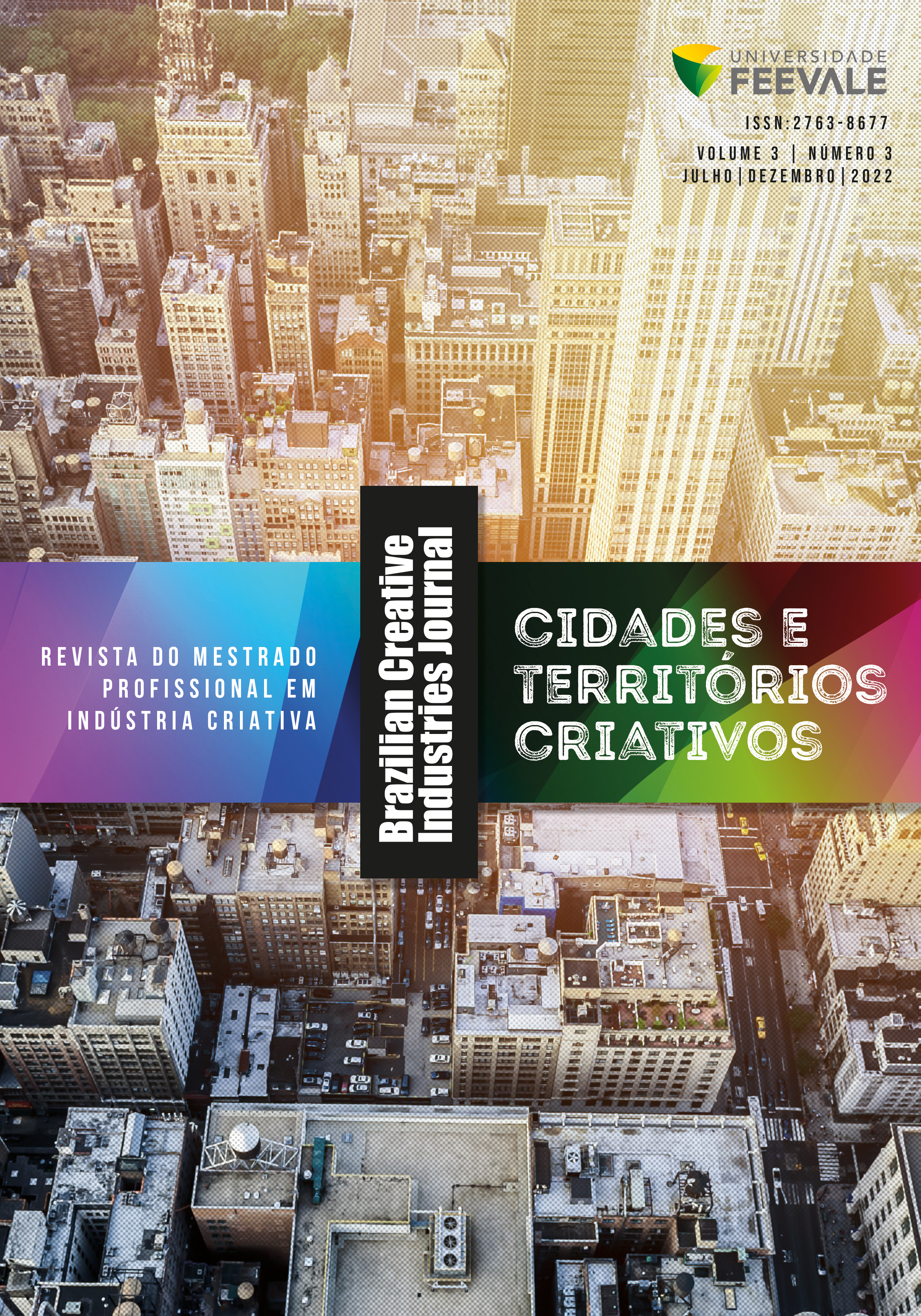AGLOMERADOS URBANOS E AS REDES CULTURAIS – AS NOVAS FORMAS DE ORGANIZAÇÃO DO TRABALHO NA ECONOMIA CRIATIVA
DOI:
https://doi.org/10.25112/bcij.v2i2.2757Resumo
Este artigo tem como objetivo discutir a relação entre as aglomerações urbanas, denominadas Centros Criativos, e a produção cultural e criativa organizada em redes. O artigo parte das transformações político-econômicas ocorridas a partir de 1980 e seus impactos nas políticas públicas para compreender como os polos criativos fortalecem as novas dinâmicas de organização do trabalho no Campo da Produção Cultural e Criativa.
Referências
British Council. The Creative Hubs Report. 2016. Disponível em: https://www.researchgate.net/publication/319245548_The_Creative_Hubs_Report_2016). Acesso em: 31 jun. 2021.
BRITISH COUNCIL. Guia Prático para o Mapeamento das Indústrias Criativas. Observatório Latino Americano do direito autoral, 2012.
Caves, R. E. Creative industries. Cambridge, MA: Harvard University Press, 2000.
European Creative Hubs Network. Creative Hubs Barometers 2017 - Capturing the profile and evolution of creative hubs throughout Europe. 2017. Disponível em: https://www.researchgate.net/publication/345602243_Creative_Hubs_Barometer_2017_-_Capturing_the_profile_and_evolution_of_creative_hubs_throughout_Europe. Acesso em: 30 jun. 2021.
European Creative Hubs Network. Project evaluation SUMMARY REPORT. 2018. Disponível em: http://creativehubs.net/tools/ECHN-final-external-evaluation-SUMMARY.pdf. Acesso em: 13 mar. 2019.
Evers, H. D.; Nordin, R.; Nienkemper, P. Knowledge cluster formation in Peninsular Malaysia: The emergence of an epistemic landscape. Social Science Research Network. 2010. Disponível em: http://papers.ssrn.com/sol3/papers.cfm?abstract_id=1691008. Acesso em: 13 mar. 2019.
Florida, R. The rise of the creative class: And how it’s transforming work, leisure, community and everyday life. New York, NY: Basic Books, 2002.
Garcia, B. Experience, Prospects for the Future Cultural Policy and Urban Regeneration in Western European Cities. Lessons Local Economy, n. 19, p. 312, 2004.
Hesmondalgh, D.; Oakley K.; Lee D.; Nisbett, M. Culture, Economic and policy. New York: Palgrave Macmillan, 2015.
Hesmondalgh, D. Cultural and Creative Industries in Tony Bennett & John Frow The Handbook of Cultural Analysis. London: SAGE, 2008.
Hewison, R. Cultural Capital: the rise and fall of Creative Britain. London: Verso, 2014.
HIVOS Emerging Trends for Creative Hubs. 2017. Disponível em: https://southern-africa.hivos.org/blog/emerging-trends-for-creative-hubs-in-southern-africa/ Acesso em: 31 jun. 2021.
Howkins, J. The creative economy: How people make money from ideas. London: Penguin, 2001.
Landry, C. The creative city: a toolkit for urban innovators. London: Earthscan, 2000.
Markusen, A. Urban development and the politics of a creative class: evidence from a study of artists. Environment and Planning A, v. 38, p. 1921-1940, 2006.
Mommaas, H. Cultural Clusters, and the Post-industrial City: Towards the Remapping of Urban Cultural. Policy Urban Studies, v. 41, n. 3, p. 507–532, March 2004.
NESTA. Next Gen: Transforming the UK into the world’s leading talent hub for the video games and visual effects industries. 2011. Disponível em: https://media.nesta.org.uk/documents/next_gen_wv.pdf. Acesso em:14 mar. 2019.
NESTA. Criativity vs Robot the Creative Economy and the future of employment. 2015. Disponível em: https://media.nesta.org.uk/documents/creativity_vs._robots_wv.pdf. Acesso em: 14 mar. 2019.
NESTA. A Dynamic Mapping of the UK’s Creative Industries. 2013. Disponível em: https://media.nesta.org.uk/documents/a_dynamic_mapping_of_the_creative_industries.pdf. Acesso em: 14 mar. 2019.
NESTA; British Council; Hivos. Building a Learning Programme for Creative. 2018. Disponível em: https://www.nesta.org.uk/blog/building-a-learning-programme-for-creative-hubs/. Acesso em: 13 mar. 2019.
Pratt, A. Urban Regeneration: Case Study of Hoxton, London Urban Regeneration: From Arts Feel Good Factor to the Culural Economy. Urban Studies, 2004 Quaderns del CAC, n. 14, Set. – Dez, 2002.
Scott, A. The Cultural Economic: Geography and creative Field, of Creativity. Media Culture and Society, v. 21, 1999.
Timberg, S. Cultural Crash the Killing of the Creative Class. United States of America: Yale Print University, 2015.
Sacco, P.; Ferilli, G.; Blessi, G. T. From Culture 1.0 to Culture 3.0: Three Socio-Technical Regimes of Social and Economic Value Creation through Culture, and Their Impact on European Cohesion Policies. Sustainability, v. 10, n. 11, p. 3923, 2018.
VIRANI, T. Re-articulating the Creative Hub concept as a model for business support in the local creative economy: the case of Mare Street in Hackney. Creativeworks London Working Paper, n.12, 2014. Disponível em: https://qmro.qmul.ac.uk/xmlui/ handle/123456789/7251. Acesso em: 11 dez. 2020.
Downloads
Publicado
Como Citar
Edição
Seção
Licença
Copyright (c) 2022 Karina Poli Lima da Cunha

Este trabalho está licenciado sob uma licença Creative Commons Attribution 4.0 International License.


